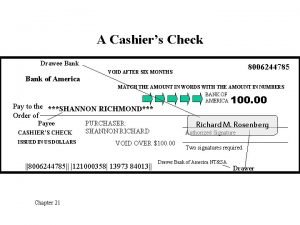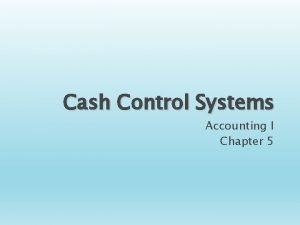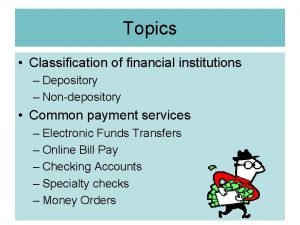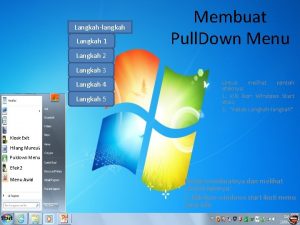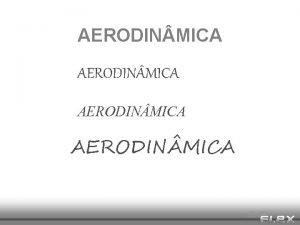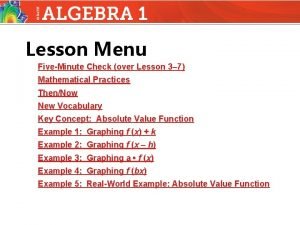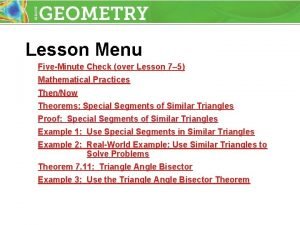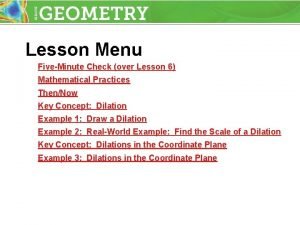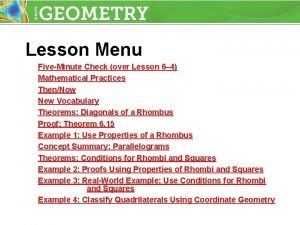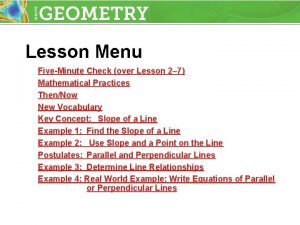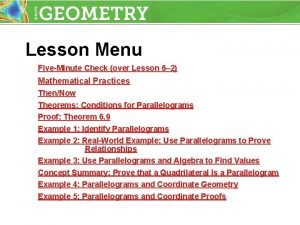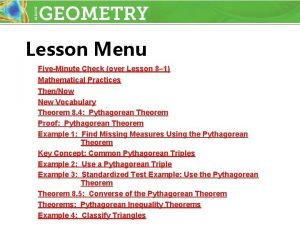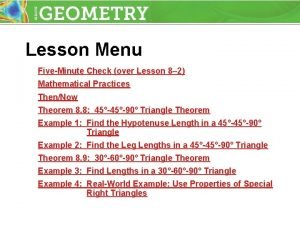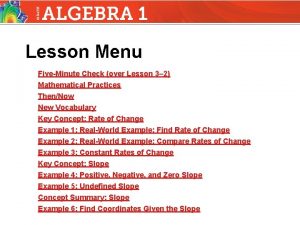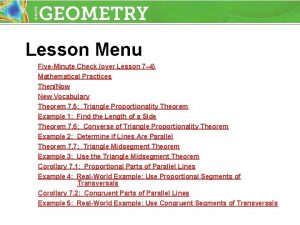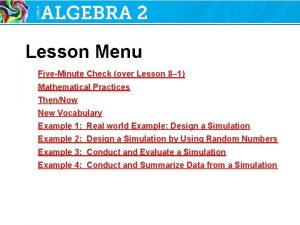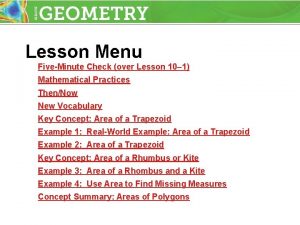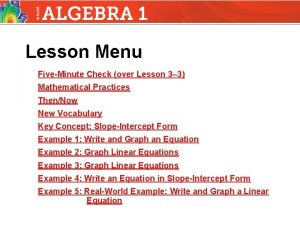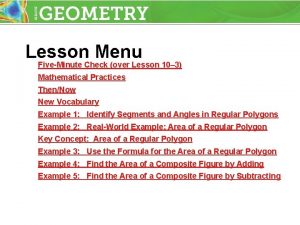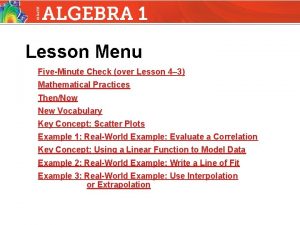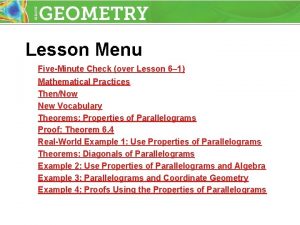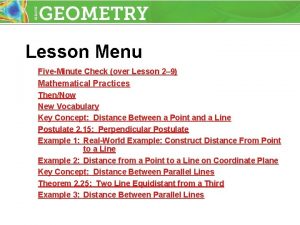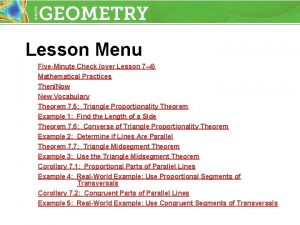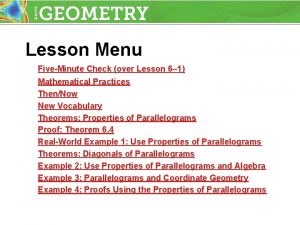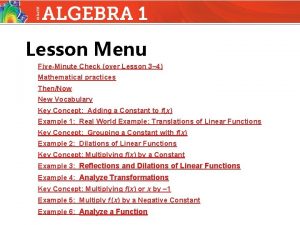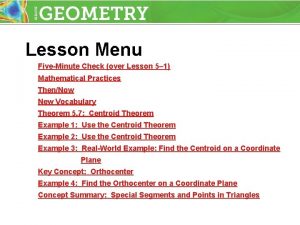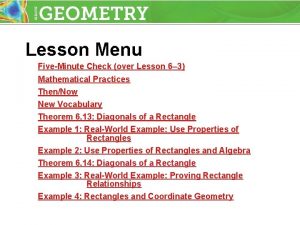Lesson Menu FiveMinute Check over Lesson 3 6


























- Slides: 26

Lesson Menu Five-Minute Check (over Lesson 3– 6) Mathematical Practices Then/Now New Vocabulary Key Concept: Greatest Integer Function Example 1: Greatest Integer Function Example 2: Real-World Example: Step Function Key Concept: Absolute Value Function Example 3: Piecewise-Defined Function Example 4: Real World Example: Piecewise-Defined Function

Warm-up




Ch. 3 -7 Piecewise and Step Functions

Mathematical Practices 4 Model with mathematics. Content Standards F. IF. 4 For a function that models a relationship between two quantities, interpret key features of graphs and tables in terms of the quantities, and sketch graphs showing key features given a verbal description of the relationship. F. IF. 7 b Graph square root, cube root, and piecewise -defined functions, including step functions and absolute value functions. Common Core State Standards © Copyright 2010. National Governors Association Center for Best Practices and Council of Chief State School Officers. All rights reserved.

You identified and graphed linear, exponential, and quadratic functions. • Identify and graph step functions. • Identify and graph piecewise-defined functions.

• step function • piecewise-linear function • greatest integer function • absolute value function • piecewise-defined function


Greatest Integer Function First, make a table of values. Select a few values between integers.

On the graph, dots represent points that are included. Circles represent points that are not included. Answer: Because the dots and circles overlap, the domain is all real numbers. The range is all integers.

A. D = all real numbers, R = all real numbers B. D = all integers, R = all integers C. D = all real numbers, R = all integers D. D = all integers, R = all real numbers

Step Function TAXI A taxi company charges a fee for waiting at a rate of $0. 75 per minute or any fraction thereof. Draw a graph that represents this situation. The total cost for the fee will be a multiple of $0. 75, and the graph will be a step function. If the time is greater than 0 but less than or equal to 1 minute, the fee will be $0. 75. If the time is greater than 2 minutes but less than or equal to 3 minutes, you will be charged for 3 minutes, or $2. 25.

Step Function Answer:

SHOPPING An on-line catalog company charges for shipping based upon the weight of the item being shipped. The company charges $4. 75 for each pound or any fraction thereof. Draw a graph of this situation.

A. C. B.


Piecewise-defined Function Graph the first expression. Create a table of values for when x < 0, f(x) = –x, and draw the graph. Since x is not equal to 0, place a circle at (0, 0).

Next, graph the second expression. Create a table of values for when x ≥ 0, f(x) = –x + 2, and draw the graph. Since x is equal to 0, place a dot at (0, 2).

Piecewise-defined Function Answer: D = all real numbers; R = all real numbers

A. D = all real numbers, R=y|y≤ 0 B. D = x | x ≥ 1, R=y|y≤ 4 C. D = x | x ≤ 1, R=y|y≤ 0 D. D = all real numbers, R=y|y≤ 4

Piecewise-Defined Function


First piece: The slope shows that the hiker walks at a rate of 3 mi/h for the first hour she hikes. Second piece: The constant function value of 3 shows that the hiker stops walking after 1 hour and pauses for the next 0. 5 hour. Third piece: The slope of 2 shows that the hiker walks at a rate of 2 mi/h beginning 1. 5 hours after she started.

A. D = y│y ≤ – 2, y > 2, R = all real numbers B. D = all real numbers, R = y│y ≤ – 2, y > 2 C. D = all real numbers, R = y│y < – 2, y ≥ 2 D. D = all real numbers, R = y│y ≤ 2, y > – 2
 Behavior check in check out sheet
Behavior check in check out sheet Behavior check in check out sheet
Behavior check in check out sheet Check in check out
Check in check out Check in check out system for students
Check in check out system for students Jobbank
Jobbank Character generation methods in computer graphics
Character generation methods in computer graphics What is check in check out
What is check in check out Check-in/check-out intervention template
Check-in/check-out intervention template Collision forces quick check
Collision forces quick check Restrictive check endorsement
Restrictive check endorsement Check my progress vocabulary check
Check my progress vocabulary check Non depository institutions
Non depository institutions Langkah-langkah perencanaan menu
Langkah-langkah perencanaan menu Fungsi menu dan ikon pada microsoft excel
Fungsi menu dan ikon pada microsoft excel Difference between classical menu and modern menu
Difference between classical menu and modern menu Sebutkan langkah memulai browsing
Sebutkan langkah memulai browsing Menu pull down exit terdapat pada menu
Menu pull down exit terdapat pada menu Over the mountain over the plains
Over the mountain over the plains Siach reciting the word over and over
Siach reciting the word over and over Handing over and taking over the watch
Handing over and taking over the watch Check the old lesson
Check the old lesson Check the old lesson
Check the old lesson Module eleven lesson one self check quiz
Module eleven lesson one self check quiz Chapter 12 lesson 2 conflicts over land
Chapter 12 lesson 2 conflicts over land Lesson 1 trouble over taxes
Lesson 1 trouble over taxes 2019 phonics screening check
2019 phonics screening check Voyage scolaire provence
Voyage scolaire provence




